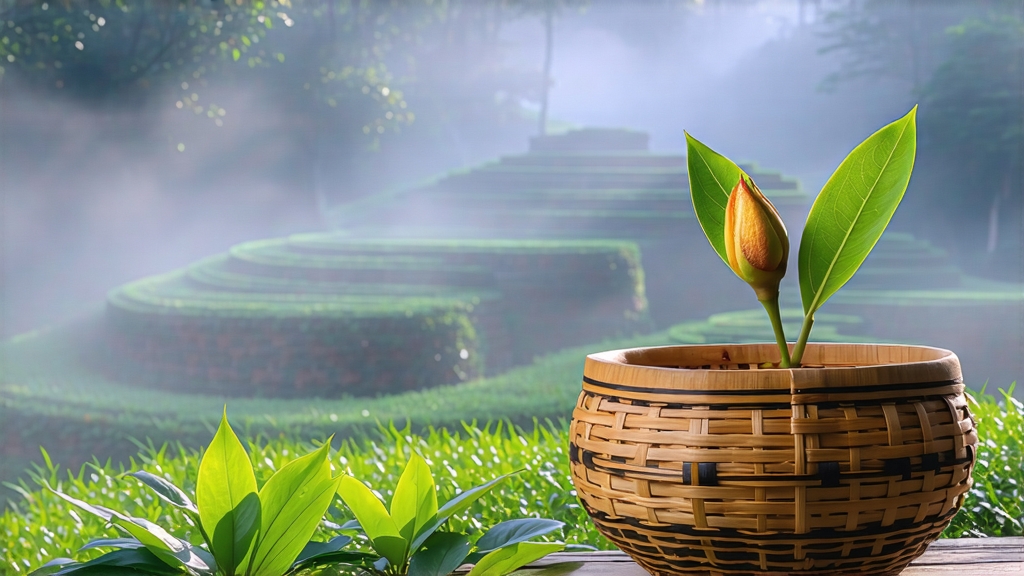
Tucked high on the northern rim of the Sichuan Basin, where humid clouds roll up the southern slopes of the Qinghai-Tibetan Plateau, lies Meng Ding Mountain, the cradle of the world’s oldest cultivated tea garden. Among the cloud-veiled terraces, one bush produces a bud so pale it glows like early morning moonlight, yet after three nights of sealed warmth it emerges burnished in the color of antique gold. That bud is Meng Ding Huang Ya—Meng Ding Yellow Bud—the most discreet yet aristocratic member of China’s tiny yellow tea family. While green teas chase freshness and black teas flaunt richness, yellow teas pursue a whispered complexity achieved only through the almost-lost art of “sealed yellowing.” To understand Meng Ding Huang Ya is to step into a hidden chapter of Chinese tea history, one scented with pine smoke from Tang-dynasty tribute caravans and echoing with Song-era poems that praised its “honeyed dew.”
Historical scrolls first record Meng Ding tea in 53 BCE, when the Daoist herbalist Wu Lizhen planted seven tea bushes on the summit, believing the mountain’s mist to be the breath of dragons. By the Tang dynasty (618-907 CE) the tea was already imperial tribute; caravans carried it along the Jianmen Pass to Chang’an, wrapped in bamboo sheaths lined with camphor leaves to keep the buds from yellowing too soon. The Song emperor Huizong, himself a skilled tea connoisseur, declared Meng Ding one of the two “Cloud Teas” worthy of court ceremony. Yet the yellow variant did not appear in writing until the late Ming, when a Sichuan tea master named Jiang Shi accidentally left a basket of freshly fixed buds under a hemp cloth for two humid days. Upon unwrapping he found the leaves had turned a light primrose, their fragrance transformed from bright bean to warm chestnut. The accident became technique, and Meng Ding Huang Ya was born.
Today fewer than 200 mu (about 13 hectares) of authentic Meng Ding Huang Ya survive, scattered among five villages above 1,000 m. The cultivar is a local shrub-type Camellia sinensis var. sinensis known as “Gan Cha Zhong,” characterized by tiny leaves, thick cuticle, and an unusually high ratio of bud to leaf—ideal for the yellowing process. Picking occurs for only twenty days each spring, beginning when the bud reaches 1.5–2 cm yet still unfurls like a miniature spear. One kilogram of finished tea demands roughly 45,000 buds, all plucked before seven in the morning so that mountain dew acts as a natural protective film.
The craft begins with gentle pan-firing in a bamboo-lined wok set to 160 °C. The tea master uses only the heel of her hand to press and toss the buds for three minutes, deactivating enzymes while preserving a faint rim of green at the stem. Next comes the unique “men huang” (sealed yellowing) stage: the warm leaves are piled 5 cm deep inside square bamboo crates, covered with wet hemp cloth, and placed in a cave-like room kept at 28 °C and 75 % humidity. Over the next 48 hours the leaf pigments gently oxidize, chlorophyll degrades into pheophytin, and catechins polymerize, creating the tea’s signature yellow liquor and mellow “chestnut-honey” note. Every six hours the pile is turned by hand to release trapped heat, a ritual called “fan dui” that demands the same intuition a baker uses when proofing sourdough. Finally the buds are given a low-temperature bake over a pine-charcoal brazier set at 60 °C, a step that fixes the color and adds a whisper of smokiness reminiscent of the old Tang caravan days.
Because the leaf is so young and the yellowing so delicate, Meng Ding Huang Ya must be brewed with the precision of a chemist and the calm of a monk. Begin with mountain spring water whose total dissolved solids sit between 30–80 ppm; higher mineral content will dull the ethereal aromatics. Pre-warm a thin-walled 150 ml porcelain gaiwan, then add 3 g of tea. Shake the lid gently to awaken the buds; you should detect a scent of fresh corn silk, pine sap, and distant apricot. For the first infusion, use water cooled to 75 °C and pour in a high, thin stream to aerate the liquor. Steep 45 seconds. The resulting liquid is the color of